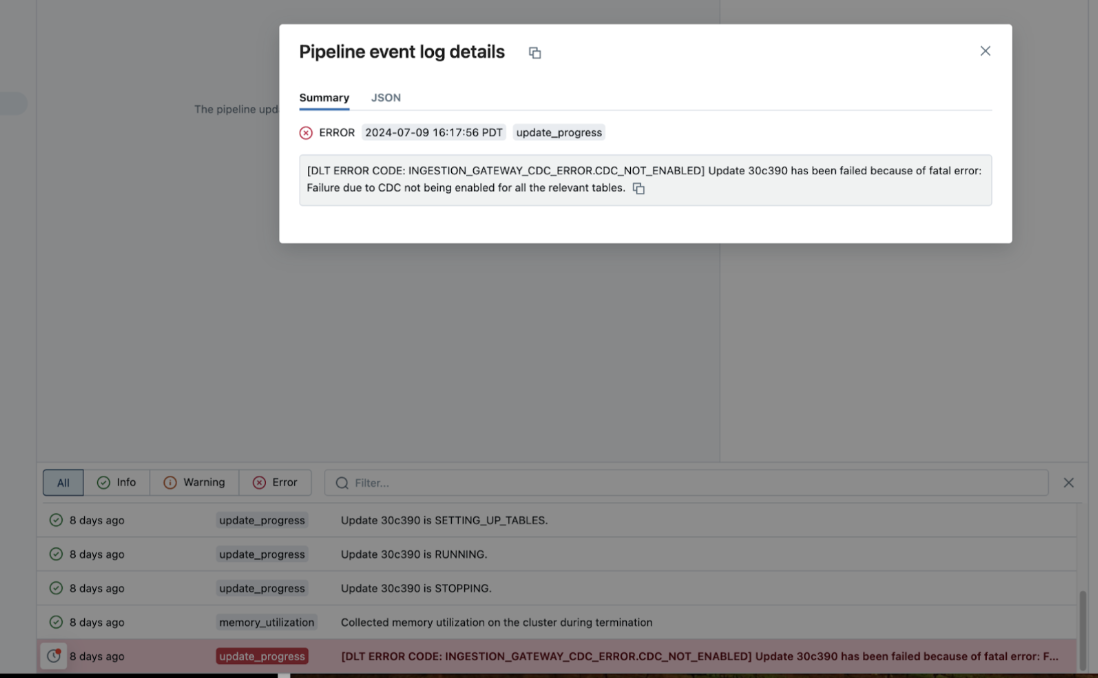Microsoft SharePoint インジェストのトラブルシューティング
ベータ版
SharePoint コネクタはベータ版です。ワークスペース管理者は、 プレビュー ページからこの機能へのアクセスを制御できます。「Databricks プレビューの管理」を参照してください。
このページでは、DatabricksLakeflowコネクトのMicrosoft SharePointコネクタに関する一般的な問題とその解決方法について説明します。
一般的なパイプラインのトラブルシューティング
実行中にパイプラインが失敗した場合は、失敗したステップをクリックし、エラー メッセージにエラーの性質に関する十分な情報が含まれているかどうかを確認します。

また、右側のパネルで アップデート詳細 をクリックし、 ログ をクリックして、パイプラインの詳細ページからクラスタリング ログを確認してダウンロードすることもできます。 ログをスキャンしてエラーまたは例外を探します。

SharePoint ファイルへのアクセスを制限する
コネクタがアクセスできる SharePoint ファイルを制限するには、制限された SharePoint アクセス許可を持つ専用の Entra ID ユーザーを作成し、そのアカウントで SharePoint に対して認証します。
バックグラウンド: コネクタは、アプリのみのアクセス (M2M OAuth) をサポートしていません。このモデルでは、アプリはサービスプリンシパルを使用してそれ自体として認証され、管理者は、そのサイト内のすべてのファイルを含む SharePoint サイト全体へのアクセスを許可します。 代わりに、コネクタは委任アクセス (U2M OAuth) を使用します。このモデルでは、コネクタは Microsoft Entra ID ユーザーに代わって動作し、ユーザーが表示するアクセス許可を持つファイルにのみアクセスできます。
認証エラー
OAuth エラーが発生した場合は、次のコードを実行して、更新トークンが WAI であることを確認します。
# Fill in these values
refresh_token = ""
tenant_id = ""
client_id = ""
client_secret = ""
site_id = ""
# Get an access token
import requests
# Token endpoint
token_url = f"https://login.microsoftonline.com/{tenant_id}/oauth2/v2.0/token"
scopes = ["Files.Read.All"]
scope = " ".join(["https://graph.microsoft.com/{}".format(s) for s in scopes])
scope += (" offline_access")
# Parameters for the request
token_params = {
"client_id": client_id,
"client_secret": client_secret,
"grant_type": "refresh_token",
"refresh_token": refresh_token,
"scope": scope
}
# Send a POST request to the token endpoint
response = requests.post(token_url, data=token_params)
response.json()
access_token = response.json().get("access_token")
You should get an access token here. You can then check if the access token is able to list all the drives in your SharePoint site.
# List all drives
url = f"https://graph.microsoft.com/v1.0/sites/{site_id}/drives"
# Authorization header with access token
headers = {
"Authorization": f"Bearer {access_token}",
"Accept": "application/json"
}
# Send a GET request to list files with specific extensions
requests.get(url, headers=headers).json()